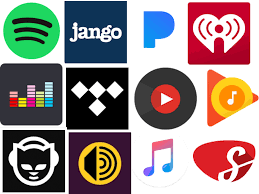The Impact of Streaming Services on the Music Industry
The music industry has undergone a profound transformation in recent years, thanks to the rise of digital streaming services. Gone are the days of physical CDs and downloads dominating the music consumption landscape. In this article, we will explore the significant impact that streaming services have had on the music industry, from the way we listen to music to the economics behind artists' earnings.
The Rise of Streaming
Streaming services such as Spotify, Apple Music, and Amazon Music have become household names, offering users access to vast libraries of music at their fingertips. The convenience of streaming has led to a seismic shift in the way people consume music. Listeners no longer need to buy individual albums or songs; instead, they pay a monthly subscription fee for unlimited access to an extensive catalog of tracks. Here is my Spotify station as an independent songwriter and composer:

Accessibility and Convenience
One of the most apparent impacts of streaming services is the unparalleled accessibility and convenience they offer. Listeners can create personalized playlists, explore new genres, and discover emerging artists with ease. The ability to stream music on various devices, from smartphones to smart speakers, has made music a ubiquitous part of our lives. This accessibility has democratized music consumption, allowing artists from all corners of the globe to reach a global audience.
The Decline of Physical Sales and Downloads
With the proliferation of streaming, physical music sales and digital downloads have declined significantly. CD sales have plummeted, and platforms like iTunes have seen a decline in popularity. While vinyl records have experienced a resurgence among collectors, they remain a niche market compared to the scale of streaming.
Economic Impact on Artists
While streaming has brought unprecedented access to music, it has also sparked debates about its economic impact on artists. Critics argue that streaming platforms pay artists relatively low per-stream royalties, making it challenging for musicians to earn a sustainable income. This is especially true for independent and lesser-known artists who lack the bargaining power of major record labels.
On the flip side, streaming has allowed artists to bypass traditional gatekeepers and promote their music independently. It has also shifted the focus from album sales to live performances, merchandise sales, and brand partnerships as sources of revenue. Successful artists can leverage streaming platforms to build a global fan base and generate income through various avenues.
The Power of Algorithms and Discovery
Streaming services employ sophisticated algorithms to curate playlists and recommend music tailored to individual preferences. This has changed the way music is discovered, with listeners relying on algorithms to introduce them to new songs and artists. On one hand, this can lead to greater exposure for emerging musicians. On the other hand, concerns about the homogenization of music and the power of algorithms in shaping taste have arisen.
Challenges and Future Outlook
The music industry's reliance on streaming services has its challenges. The debate over fair compensation for artists continues, and streaming platforms must grapple with issues of copyright infringement and licensing agreements. Moreover, the sheer volume of music available can be overwhelming for listeners, making it difficult for smaller artists to stand out.
Looking ahead, the future of streaming will likely involve a continued evolution of business models and artist compensation structures. The music industry will also need to adapt to emerging technologies, such as virtual reality concerts and immersive music experiences, which could further transform the landscape.
The Expectation of Free Music and Its Profound Impact on the Record Business
In the digital age, the expectation of free music has become a prevailing trend, profoundly impacting the record business. The evolution of technology and the advent of the internet have reshaped the music industry, with listeners increasingly accustomed to accessing music without direct financial cost. In this article, we will delve into the roots of this expectation, its consequences for artists and the record industry, and explore potential solutions to address the challenges it presents. Check out my original music web site: www.ToddOMusic.com
The Proliferation of Piracy
One of the primary drivers behind the expectation of free music is the proliferation of online piracy. Peer-to-peer file-sharing networks, torrent websites, and illicit streaming platforms have made it easier than ever for individuals to obtain copyrighted music without paying for it. This widespread practice has conditioned many to believe that music should be free and easily accessible.
Lost Revenues for Artists and Labels
The impact of this expectation on the record business is most acutely felt in terms of lost revenue. Piracy and the expectation of free music have contributed to a significant decline in physical album sales and digital downloads. This decline has implications not only for artists but also for record labels, which traditionally relied on these revenue streams to support the creation and promotion of new music.
Independent and emerging artists, in particular, face challenges in monetizing their work. With the devaluation of recorded music, they must increasingly rely on other income sources such as live performances, merchandise sales, and crowdfunding campaigns. Established artists, while still able to generate substantial revenue from touring and endorsements, may see diminished returns on their recorded music.
The Role of Streaming Services
Streaming services, while providing a legal and convenient alternative to piracy, have also contributed to the expectation of free music. Many users opt for free, ad-supported tiers of platforms like Spotify and YouTube, allowing them to access a vast library of music without direct payment. While these services do generate revenue through advertising, the per-stream royalties paid to artists are often criticized as insufficient.
Subscription models offered by streaming platforms have helped counteract this expectation to some extent, but convincing users to pay for music remains a challenge. Additionally, the subscription revenue is divided among many artists, favoring popular acts over smaller, independent musicians.
Addressing the Challenge
Addressing the expectation of free music in the digital age is a complex issue, but there are several potential strategies to mitigate its impact:
- Education: Industry stakeholders can engage in public awareness campaigns to educate consumers about the importance of supporting artists by purchasing music legally.
- Value Proposition: Artists and labels can emphasize the value of music as a unique and creative product worth paying for, emphasizing the impact of free access on the sustainability of music creation.
- Innovative Business Models: Exploring new business models, such as exclusive content releases, merchandise bundles, and fan engagement platforms, can help artists and labels diversify their revenue streams.
- Stricter Copyright Enforcement: Governments and international bodies can strengthen copyright enforcement measures to combat piracy and discourage illegal distribution of music.
The expectation of free music, fueled by piracy and the availability of ad-supported streaming options, has undoubtedly posed challenges for the record business. It has disrupted traditional revenue models and reshaped how artists and labels approach the creation and distribution of music. While there are no easy solutions, a combination of education, innovative business models, and improved copyright enforcement can help address this issue and ensure that music creators receive fair compensation for their work in the digital age.
Music Licensing
Demystifying Music Licensing: How It Works and Its Vital Role in the Music Industry
Many songwriters and composers have realized you need an insane amount of plays on Spotify or Apple Music to make pennies. The game is rigged against songwriters and composers. So where are songwriters and composers making some money? Live concerts and music licensing. Music licensing is a fundamental aspect of the music industry, facilitating the legal use of music in various contexts, from films and television shows to commercials, video games, and public performances. This complex system ensures that artists and composers are compensated for their creative work while allowing businesses and media producers to use music to enhance their content or events. In this article, we will demystify music licensing, exploring its key components, processes, and its vital role within the music industry.
Understanding the Basics of Music Licensing
Music licensing involves granting permission to use a copyrighted musical composition or sound recording for specific purposes. There are two primary types of licenses:
- Sync License: This type of license covers the use of music in synchronization with visual media. It is commonly used in films, TV shows, advertisements, video games, and even YouTube videos. The process involves obtaining permission from both the copyright holder of the musical composition (usually the songwriter or publisher) and the copyright holder of the sound recording (often the record label).
- Public Performance License: This license is required when music is played or performed in public spaces or broadcasted over the airwaves. Examples include live concerts, radio broadcasts, music played in restaurants, and background music in retail stores. Performance rights organizations (PROs), such as ASCAP, BMI, and SESAC in the United States, collect royalties from venues and broadcasters and distribute them to songwriters and publishers.
The Key Players in Music Licensing
Several key players are involved in the music licensing ecosystem:
- Artists and Composers: These are the creators of the music, including songwriters, composers, and performers. They own the copyrights to their works.
- Publishers: Music publishers represent songwriters and composers. They help manage and administer the rights to musical compositions, negotiate licensing deals, and collect royalties on behalf of their clients.
- Record Labels: Record labels hold the copyrights to sound recordings. They negotiate licensing deals for the use of these recordings and often collaborate with music publishers for synchronization licenses.
- Music Licensing Companies: These specialized agencies help businesses and media producers secure the rights to use music. They act as intermediaries between copyright owners and licensees, streamlining the licensing process.
The Licensing Process
The process of obtaining a music license can vary depending on the intended use and the music's rights holders. However, a typical licensing process involves the following steps:
- Identify the Music: Determine the specific music composition and sound recording you wish to use and identify the copyright owners.
- Contact Rights Holders: Reach out to the copyright owners or their representatives to negotiate the terms of the license. This may involve discussing fees, duration, territory, and usage rights.
- Negotiate and Execute the License Agreement: Once terms are agreed upon, a formal license agreement is drafted and signed by both parties, outlining the rights and obligations of each party.
- Payment of Royalties: Licensees are typically required to pay royalties to the copyright owners, either as a one-time fee or ongoing payments based on usage.
- Compliance and Reporting: Licensees are often required to report on how the music is used and provide periodic statements of usage to ensure compliance with the agreement.
Music licensing plays a vital role in the music industry by facilitating the legal and fair use of music in various contexts. It allows artists, composers, and copyright holders to be compensated for their creative work while enabling businesses and media producers to enhance their content and events with music. Understanding the intricacies of music licensing is essential for anyone involved in using music for commercial or creative purposes, ensuring that the rights of all parties involved are respected and upheld.
Trevor Talks Turkey
Conclusion
Streaming services have undeniably revolutionized the music industry, offering unprecedented accessibility and convenience to listeners worldwide. While challenges persist, including concerns about artist compensation and the power of algorithms, streaming has opened up new avenues for artists and reshaped the way we engage with music. As technology continues to evolve, the music industry will undoubtedly face further transformations, making it an exciting time for both creators and consumers of music. Click here to read about how to create your own playlists.


